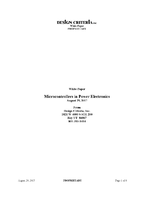ASTM Symposium covers graphite testing for nuclear applications.
Press Release Summary:
Graphite Testing for Nuclear Applications: The Significance of Test Specimen Volume and Geometry and the Statistical Significance of Test Specimen Population (September 19–20) will focus on testing of as-manufactured graphite. Principal objectives are collecting evidence for singular reference; providing technical basis for restrictions on test specimen size in ASTM standards; providing guidance on tests for valid measure of given property; and considering development of new standards.
Original Press Release:
ASTM International Symposium on Graphite Testing for Nuclear Applications
W. CONSHOHOCKEN, Pa.—A symposium on Graphite Testing for Nuclear Applications: The Significance of Test Specimen Volume and Geometry and the Statistical Significance of Test Specimen Population, will be held Sept. 19-20 at the Seattle Hilton in Seattle, Wash. Sponsored by Subcommittee D02.F0 on Manufactured Carbon and Graphite Products, part of ASTM International Committee D02 on Petroleum Products and Lubricants, the symposium will be take place after the 14th International Nuclear Graphite Specialist meeting.
Currently the most comprehensive set of test standards for graphite has been published by ASTM International. These standards and practices have been devised principally to meet the requirements of graphite manufacturers who generally do not have constraints on test sample volume or geometry. In addition, industry looks for guidance as to how many specimens should be tested to constitute a valid test. The symposium, which will focus on the testing of as-manufactured graphite, has four principal objectives:
To collect evidence on test specimen size effects for a range of properties, test specimen geometries and test specimen volumes, with a view to collating data into a single reference;
To provide a technical (theoretical and/or experimental) basis for restrictions on test specimen size in ASTM standards;
To provide guidance on the number of tests necessary for a valid measure of a given property; and
To consider development of new standards.
Online registration is now open and closes Sept. 19. The attendance fee for ASTM members and presenters is $160 USD online and $185 USD onsite, while the fee for non-ASTM members is $185 USD online and $210 USD onsite. There is no fee for students with a valid ID.
Visit www.astm.org/D02Sept2013 for online registration and additional information.
Additional technical information is available from symposium co-chairmen Tim Burchell, Oak Ridge National Laboratory, Oak Ridge, Tenn. (phone: 865-576-8595; burchelltd@ornl.gov); William Windes, Idaho National Laboratory, Idaho Falls, Idaho (phone: 208-526-6985; william.windes@inl.gov); Nassia Tzelepi, National Nuclear Laboratory, Seascale, Great Britain (phone: 44 789-483-6532;Â Â nassia.tzelepi@nnl.co.uk); and Steve Duffy, Cleveland State University, Stow, Ohio (phone: 330-388-0511; sduffy@crtechnologies.com).
ASTM International is one of the largest international standards development and delivery systems in the world. ASTM International meets the World Trade Organization (WTO) principles for the development of international standards: coherence, consensus, development dimension, effectiveness, impartiality, openness, relevance and transparency. ASTM standards are accepted and used in research and development, product testing, quality systems and commercial transactions.
ASTM Staff Contact: Hannah Sparks, Phone: 610-832-9677; hsparks@astm.org




